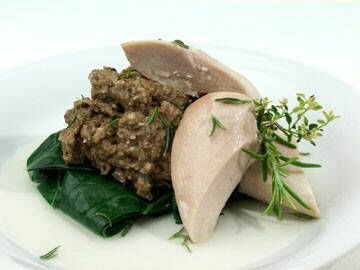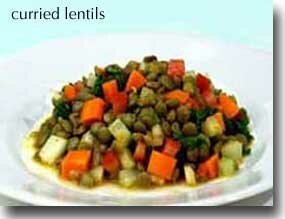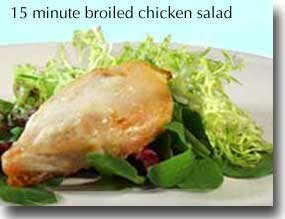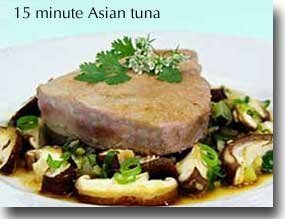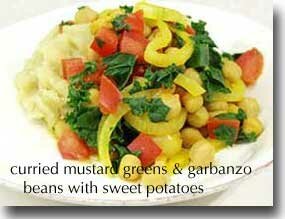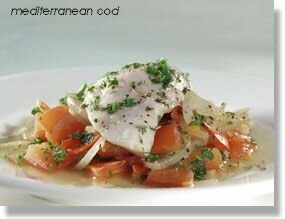healthy food tip and recipe
Today's Recipe
If you don't know what to serve for dinner tonight ...
This is a great meal-in-one dish that can be prepared in just 25
minutes using our Healthy Sauté method of cooking, which uses no heated
oils. Enjoy!
Southwestern Cod Sauté
 Prep and Cook Time:
Prep and Cook Time: 15 minutes, Cooking Time: 10 minutes
Ingredients:
- 1 medium onion, cut in half and sliced medium thick
- 6 medium cloves garlic, pressed
- 1-2 tsp minced jalapeno pepper*, seeds removed
- 1 TBS chicken broth
- 2 cups diced zucchini into 1/2-inch cubes)
- 1 lb cod filets, cut into 1 inch pieces
- 15 oz can diced tomatoes
- 3 TBS fresh lemon juice
- 2 TBS chopped fresh cilantro
- 1 TBS chopped fresh oregano
- 1 ripe but firm medium avocado, diced into 1-inch pieces
- salt and black pepper to taste
- *if you like your food less spicy, consider using less jalapeno pepper
Directions:
- Cut onion and press garlic and let sit for at least 5 minutes to bring out their health-promoting properties:.
- Prepare all other ingredients before starting the sauté.
- Heat 1 TBS broth in a 10-12 inch stainless steel skillet.
Healthy Sauté onion in broth over medium heat, stirring frequently for 5
minutes.
- Add garlic, zucchini, jalapeno, and cod and continue to sauté for another 2 minutes, stirring frequently.
- Add rest of ingredients, except avocado, and cook for another 2 minutes. Add avocado, season with salt, pepper and serve.
Serves 4
Serving Suggestion:
Serve with
Printer Friendly Version of
Southwestern Cod Sauté
In-Depth Nutritional Profile for
Southwestern Cod Sauté
Healthy Food Tip
Is cocoa healthy, and if it is, why is it not included on the WHFoods list?
Cocoa is not included among the World's Healthiest Foods because
it isn't a whole food or intact part of a plant (like a raw nut or
seed). Cocoa is a processed food component. While it is made from seeds
found within pods on the cacoa tree (
Theobroma cacao), it's only
after these seeds have been fermented, dried, and sometimes treated with
other additives that the commercial product cocoa is formed.
Cocoa processing has a definite connection to the manufacture of
chocolate, but the two processes are distinct. The production of cocoa
powder and cocoa butter, which are used to make chocolate, requires
additional processing steps after the initial processing of the cocoa.
As a processed food component, cocoa is less healthy than a whole
natural food. Even so, cocoa is developing a more and more impressive
research history with respect to its flavonoid content and heart-related
benefits. Flavonols found in cocoa appear to be especially helpful in
protecting the blood vessel linings. By helping protect these blood
vessel structures, cocoa flavonols may also help prevent high blood
pressure.
Studies of cocoa are mixed, however, in terms of the potential
benefits for different age groups and for persons with and without
existing chronic disease. For example, postmenopausal women with high
cholesterol seem to obtain significant cardiovascular benefits from the
consumption of cocoa. Aged men with diagnosed coronary artery disease,
on the other hand, do not appear to derive these same benefits.
Product quality is very important when it comes to cocoa because
residues of lead and other potential toxins may be present in
non-organically produced cocoa. Organic cocoa powder, organic cocoa
butter, and organic cocoa are labeling terms you should look for when
purchasing cocoa-containing products.
References
Buijsse B, Feskens EJ, Kok FJ, et al. Cocoa Intake, Blood Pressure, and Cardiovascular Mortality: the Zutphen Elderly Study.
Arch Intern Med. 2006;166(4):411-7.
Dinges DF. Cocoa Flavanols, Cerebral Blood Flow, Cognition, and Health: Going Forward.
J Cardiovasc Pharmacol. 2006;47(Suppl 2):S221-3.
Engler MB, Engler MM. The Emerging Role of Flavonoid-Rich Cocoa and Chocolate in Cardiovascular Health and Disease.
Nutr Rev. 2006;64(3):109-18.
Farouque HM, Leung M, Hope SA, et al. Acute and Chronic Effects
of Flavanol-Rich Cocoa on Vascular Function in Subjects With Coronary
Artery Disease: a Randomized Double-Blind Placebo-Controlled Study.
Clin Sci (Lond). 2006;111(1):71-80.
Heiss C, Schroeter H, Balzer J, et al. Endothelial Function, Nitric Oxide, and Cocoa Flavanols.
J Cardiovasc Pharmacol. 2006;47(Suppl 2):S128-35; discussion S172-6.
Lee KW, Kundu JK, Kim SO, et al. Cocoa Polyphenols Inhibit
Phorbol Ester-Induced Superoxide Anion Formation in Cultured HL-60 Cells
and Expression of Cyclooxygenase-2 and Activation of NF-KappaB and
MAPKs in Mouse Skin in Vivo.
J Nutr. 2006;136(5):1150-5.
Manton WI. Sources of Lead in Cocoa and Chocolate.
Environ Health Perspect. 2006;114(5):A274-5; author reply A275.
Selmi C, Mao TK, Keen CL, et al. The Anti-Inflammatory Properties of Cocoa Flavanols.
J Cardiovasc Pharmacol. 2006;47 Suppl 2:S163-71; discussion S172-6.
Tokuda Y, Kashima M, Kayo M, et al. Cocoa Supplementation for
Copper Deficiency Associated With Tube Feeding Nutrition. ntern Med.
2006;45(19):1079-85.
Wang-Polagruto JF, Villablanca AC, Polagruto JA, et al. Chronic
Consumption of Flavanol-Rich Cocoa Improves Endothelial Function and
Decreases Vascular Cell Adhesion Molecule in Hypercholesterolemic
Postmenopausal Women.
J Cardiovasc Pharmacol. 2006;47(Suppl 2):S177-86; discussion S206-9.


